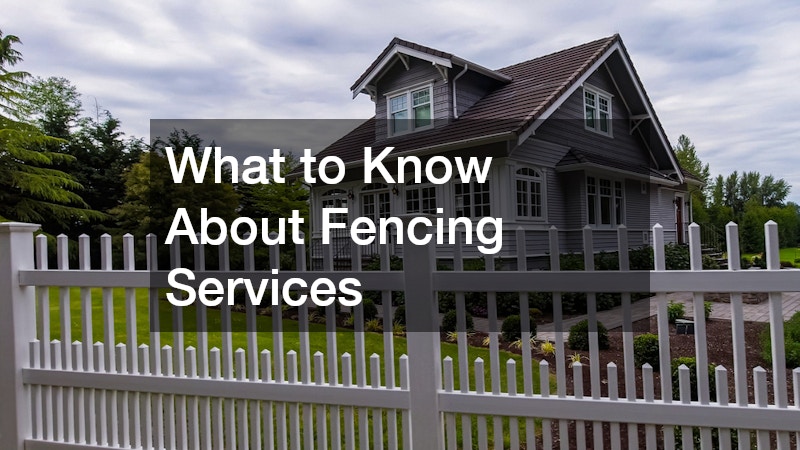
Fencing is more than just a boundary marker; it is essential to a property’s functionality, safety, and overall appearance. Whether a homeowner is interested in enhancing curb appeal, improving security, or creating a defined outdoor space, fencing plays a crucial role in shaping form and function. With so many options available, it can be overwhelming to know where to begin. This is where understanding the value of professional fencing services becomes vital. These services help property owners make informed decisions that align with their goals, budgets, and long-term maintenance expectations.
When planning a new fence or updating an existing one, it is important to consider more than just looks. Durability, purpose, materials, and placement all have to be taken into account. Different properties require different solutions, and the right choice can significantly impact how well a fence performs over time. This blog will explore several key aspects that every property owner should consider when thinking about adding or replacing a fence, from material selection to professional installation.
Understanding Different Types of Fencing
There is no one-size-fits-all solution when it comes to fencing. Each type of fence serves a different purpose and comes with its own strengths and limitations. From wood to vinyl, chain link to wrought iron, the choices can feel endless. The right fence depends on what you need most—whether it is privacy, security, aesthetics, or affordability. Taking the time to learn about each option can help ensure that the final choice complements both the property and the owner’s priorities.
For example, wood fences offer a classic look and can be customized in terms of height, style, and finish. However, they require regular maintenance to prevent rot and weather damage. Vinyl fences, on the other hand, are low-maintenance and weather-resistant, but they may be more expensive upfront. Chain link fences are durable and affordable, making them ideal for larger properties, though they provide little privacy. By comparing these different fencing types, property owners can choose a style that balances functionality and appearance.
Choosing the Right Materials for Your Needs
Selecting the right fencing material is a major decision that will influence both the look and the longevity of the fence. Some materials are known for their durability, while others are chosen for their visual appeal or ease of maintenance. It is important to weigh the pros and cons of each material, taking into account local weather conditions, long-term upkeep, and how the fence will be used. Making an informed choice now can help prevent costly repairs or replacements later on.
As an example, a homeowner in a region with high humidity or frequent rain might lean toward materials that resist moisture, such as vinyl or treated metal. Conversely, someone in a dry, sunny climate may prefer natural wood for its aesthetic warmth, provided they are prepared for occasional refinishing. If pets or children will be using the yard regularly, a sturdy and safe material like composite or aluminum could be a practical solution. Each material brings its own set of trade-offs, and the best choice will depend on the unique needs of the property.
Considering Installation and Maintenance Costs
Budgeting for a fence involves more than just calculating the cost of materials. Installation and long-term maintenance can add significantly to the overall expense. Professional installation ensures that the fence is properly aligned, secured, and built to last, which can save time and money in the long run. It is also essential to consider the level of maintenance each type of fence requires over time, as some materials may need frequent attention while others require little to no upkeep.
For instance, while a chain link fence may have a lower initial cost, it might need repairs over time if it becomes bent or rusted. A wood fence could be affordable to install, but the cost of staining or sealing it every few years adds up. On the other hand, a vinyl fence might cost more at the outset but requires minimal maintenance. Property owners should take a long-term view when evaluating costs, considering not just what they will spend today but also what they will need to invest over the fence’s lifetime.
Enhancing Security and Privacy with Fencing
Fences serve a critical function in protecting a property and maintaining personal privacy. Whether it is keeping unwanted visitors out or keeping children and pets safely inside, the right fence can provide peace of mind. Security and privacy needs will vary depending on the property and its surroundings, but every property owner should think about how their fencing choices will impact these factors.
A tall, solid wood or vinyl fence can be an effective barrier for blocking sightlines and deterring trespassers. In urban or suburban neighborhoods, privacy fences are popular for creating secluded outdoor spaces. For rural properties or areas where visibility is still important, a metal fence with decorative elements may offer both protection and style. The design and placement of the fence should reflect the specific safety and privacy concerns of the owner, while still maintaining an attractive appearance.
Hiring a Professional for Quality Service
While some property owners may consider installing a fence themselves, there are many advantages to working with a professional. Experienced fencing contractors bring specialized knowledge, tools, and techniques that ensure the fence is installed correctly and efficiently. They are also familiar with local zoning laws, property line considerations, and permit requirements, which helps avoid potential legal or logistical issues.
Adding or upgrading a fence is a significant decision that affects a property’s value, functionality, and appearance. With so many types of fences, materials, and installation options available, it can be challenging to determine the best path forward. That is why it is essential to take a thoughtful, informed approach when exploring fencing services. By understanding the various types of fences, carefully selecting materials, evaluating long-term costs, and prioritizing privacy and security, property owners can make confident choices that meet both their immediate and future needs.






